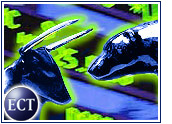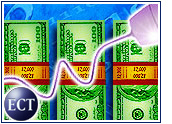
What recession? That is what you will hear from somee-tailers if you ask them how they have fared inrecent months.
According to the U.S. Department of Commerce (DOC),e-commerce sales gained 19.3 percent year over year in 2001, although total retail sales grew by just 3.3 percent.
Brick-and-mortar retailers are eagerly awaiting thespending surge that often follows economic downturns,fueled by pent-up demand.
But e-tailers — many of which cruised throughthe recession unscathed — are eyeing the imminentrecovery as an opportunity to line their pocketseven more. What gives?
Keeping Pace
Who would have guessed that some e-commerce firms, oft-heckled for their ephemeral life spans, would emergeas rock-solid, recession-defiant forces?
Clearly, many technology companies met their maker in2001. But for those that pulled through, the recessionoften was nothing more than a minor speed bump.
Steady online spending started in thefirst quarter, totaling US$7.59 billion, followed by$7.45 billion in the second quarter, the DOC reported.Consumers spent $7.47 billion online in the thirdquarter and closed out the year with a whopping $10 billion spree.
Must-Haves
Think about your spendingpatterns over the past year and a half. Chances are youshunned big-ticket items like cars, furnitureand major appliances, especially if you countedyourself among the unemployed masses.
But by and large, shoppers buy clunky, costly productsin person, not online. Therefore, it is not surprising that total retail sales slumped last year.
Now, think about a few purchases your tightened budgetallowed you to make. A half-dozen books, CDs, ahandful of birthday presents and some home-officesupplies, perhaps?
Consumers are much more likely to buy such low-ticket,commodity-type necessities online.
Hence, the 19.3 percent spike in online sales lastyear begins to make sense.
Bargain Hunters
What is more, consumers have been especiallyprice-conscious lately, bargain hunting withrelentless determination.
The Web is tailor-made for bargain hunting. Withsites like Half.com,DealTime.comand Pricegrabber.com,people can ferret out discounts in a fraction of the timeit might take to meander through a mall.
And if customers found themselves on the fence about an onlinepurchase because of shipping costs or a cash shortage,many e-tailers went out of their way to remove such obstacles.
Flexible Plan
For instance, in November 2001, Amazon.com (Nasdaq:AMZN) tapped into consumers’ long-standing penchantfor procrastination by unveiling its credit accountpayment option.
Allowing customers to “buy now, pay later,” Amazonplayed right into the recession-hampered consumermindset.
And to further grease the buying skids, the e-tail giant introduced free shipping on orders of $99 or more.
Following suit, Buy.com and Barnes & Noble.com(Nasdaq: BNBN) also treated shoppers to similar shippingdeals.
Good to Better
By aligning themselves with consumers predisposed to buylow-cost, Web-friendly merchandise, e-tailersweathered the economic slump like ducks in a downpour.
Ironically, the true impact of e-commerce is gettingharder and harder to measure because more retailers areblending online and offline sales and marketingchannels.
So, as we tip-toe into the first phases of economicrecovery, e-tailers likely will maintain or increasesales while driving at least as many in-store purchases.
That’s what they mean by “What recession?” Go figure.
Note: The opinions expressed by our columnists are their own and do not necessarily reflect the views of the E-Commerce Times or its management.

























































Social Media
See all Social Media